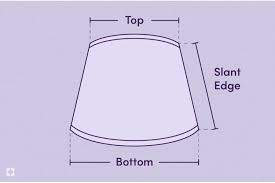How Do I Accurately Measure a Light Shade for Replacement?

Strong 8k brings an ultra-HD IPTV experience to your living room and your pocket.
Accurate measurements are crucial when selecting or replacing a light shade. Proper measurements ensure the shade fits correctly, both physically and aesthetically, with the lamp or fixture. Incorrect dimensions can lead to issues such as improper light distribution, imbalance, or difficulty in fitting the shade securely. Measuring both the diameter and height of the shade, as well as specific fittings like the fitter or clip, ensures compatibility with the fixture. Furthermore, accurate measurements prevent aesthetic mismatches and functional problems, contributing to an overall better lighting experience.
Tools and Techniques for Measuring Light Shades
To measure a light shade accurately, essential tools include a tape measure or ruler, a pencil, and a notepad for recording dimensions. For precise measurements, a laser distance meter can be helpful. Begin by ensuring the light fixture is turned off and cool to avoid accidents. Measure the shade's diameter at its widest point and its height from top to bottom. For irregular shapes, take multiple measurements at various points. These tools and techniques facilitate accurate and reliable measurements, ensuring the shade fits well with the light fixture.
How to Measure Different Types of Light Shades
Different types of light shades require specific measurement techniques. For cylindrical shades, measure both the diameter and height. For bell or drum shades, measure the top and bottom diameters, as well as the height. Pendant shades require measurements of both the diameter and the distance from the fixture to the bottom of the shade. Chandeliers and wall sconces also have unique measurement requirements, such as the distance from the fixture and dimensions relative to other parts of the lighting setup. Tailoring your measurements to the type of shade ensures proper fit and functionality.
Measuring Fitter Sizes and Mounting Types
Measuring the fitter size is essential for ensuring the shade attaches securely to the fixture. For shades with spider fittings, measure the diameter of the spider and the height of the shade. For shades with a clip-on mechanism, measure the clip's diameter and the height of the shade. Washer fittings and top ring fittings also require specific measurements of their dimensions. Accurate measurements of these fittings ensure compatibility and proper installation, preventing issues with attachment and stability.
Addressing Irregularly Shaped Shades
Measuring irregularly shaped shades involves taking multiple measurements at various points to capture the overall dimensions accurately. For example, measure the widest and narrowest diameters and the height at different points. Record these dimensions to ensure the new shade fits properly and accommodates any shape variations. This approach helps in selecting a shade that aligns well with the unique contours of the existing fixture and maintains proper functionality.
Measuring for Specific Fixtures: Pendant, Chandelier, and Wall Sconces
Each type of light fixture requires specific measurement considerations. For pendant shades, measure both the diameter and the length of the pendant. For chandeliers, measure the diameter, height, and clearance around the chandelier arms. Wall sconces require measurements of the shade's diameter, height, and the distance from the wall mount to the bottom of the shade. These measurements ensure that the shade complements the fixture’s design and fits appropriately within its intended space.
How to Measure for a Properly Fitting Lamp Shade
For lamp shades, measure the diameter and height, and consider the proportion relative to the lamp base. A common guideline is that the shade’s diameter should be about two-thirds the height of the lamp base. For height, the shade should be approximately half the height of the lamp base. These proportions ensure a balanced look and effective light diffusion, enhancing both the functionality and appearance of the lamp.
Considerations for Measuring Shades for Different Applications
Measuring light shades for various applications, such as floor lamps, table lamps, or outdoor fixtures, involves specific considerations. For floor lamps, measure the diameter, height, and distance from the floor to the bottom of the shade. For outdoor fixtures, ensure the shade is made of durable, weather-resistant materials and measure its diameter and height. Tailoring measurements to the specific application ensures that the shade meets practical and aesthetic needs.
Conclusion
Accurate measurement of light shades is essential for achieving a proper fit and functionality. By using the right tools, techniques, and considerations for different types of shades and fixtures, you can ensure that the new shade fits seamlessly with your lighting setup. Paying attention to details such as diameter, height, and specific fittings helps avoid common issues and enhances the aesthetic and practical aspects of your lighting. Whether for standard or custom shades, thorough measurements contribute to a well-coordinated and effective lighting solution.
FAQs
How do I measure the diameter of a light shade?
Measure the diameter by placing a tape measure across the widest part of the shade, ensuring it is level and perpendicular to the side. For irregular shapes, take measurements in multiple directions to find the largest diameter.
What tools are needed to measure a light shade?
Use a tape measure or ruler for accuracy. A pencil and paper are helpful for recording dimensions, and a laser distance meter can provide precise measurements if needed.
How do I measure the height of a light shade?
To measure the height, place the tape measure from the top rim of the shade to the bottom rim. Make sure the tape is straight and not angled for an accurate measurement.
What is a fitter size, and how do I measure it?
The fitter size is the part of the shade that attaches to the lamp or fixture. Measure the diameter of the fitter or ring, and if it uses a clip or screw mechanism, measure the width and height of the fitting.
How should I measure a shade for a pendant light?
Measure the diameter of the shade and the distance from the top of the pendant to the bottom of the shade. This ensures the shade will hang correctly and fit the pendant’s mounting structure.
Note: IndiBlogHub features both user-submitted and editorial content. We do not verify third-party contributions. Read our Disclaimer and Privacy Policyfor details.


